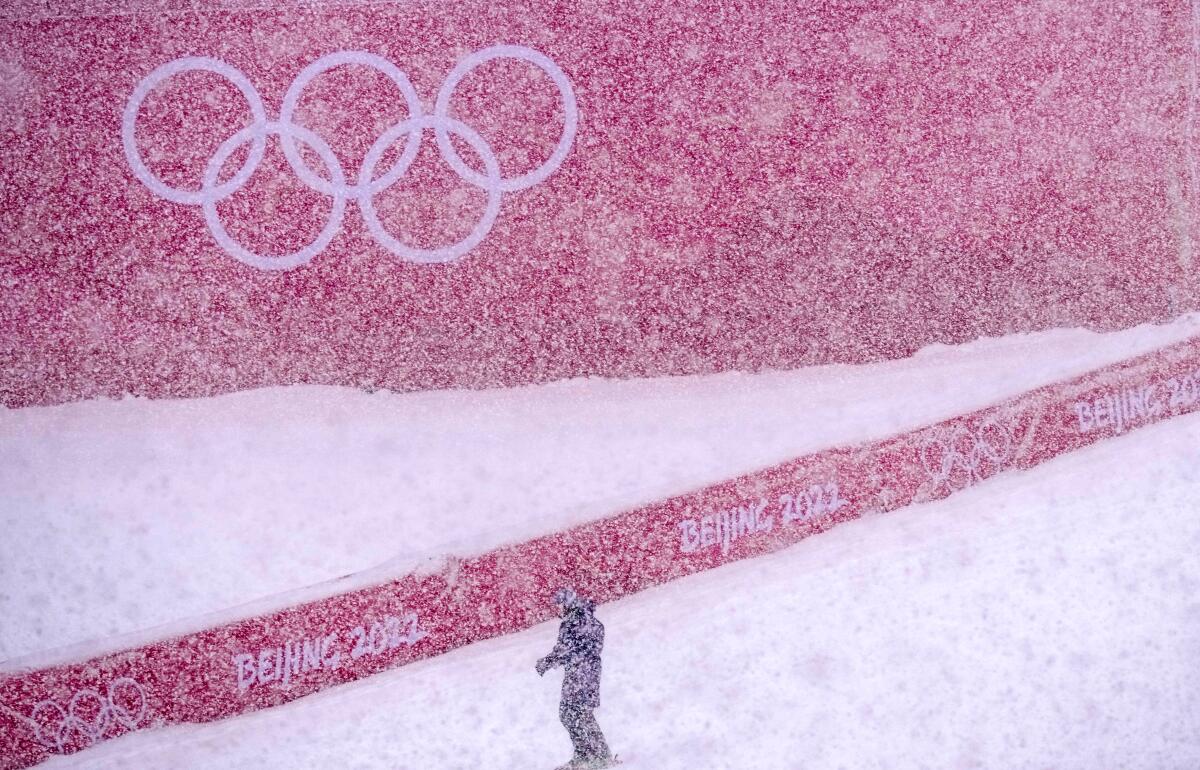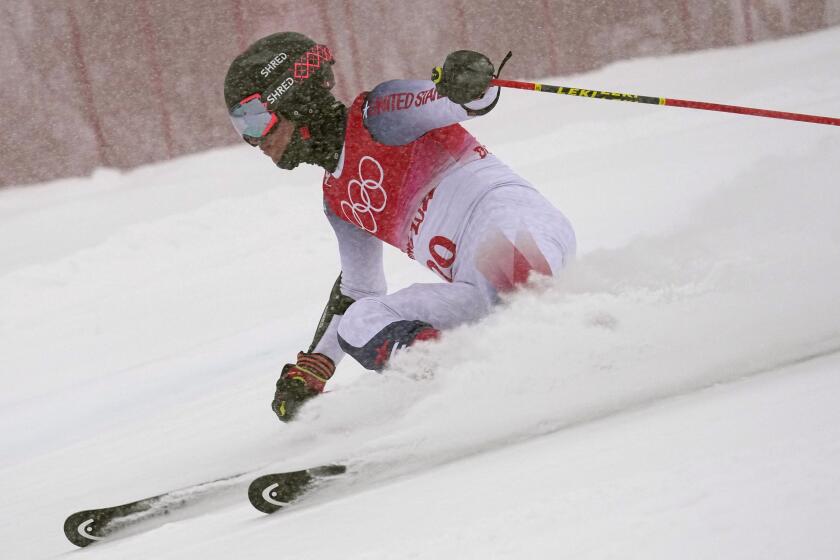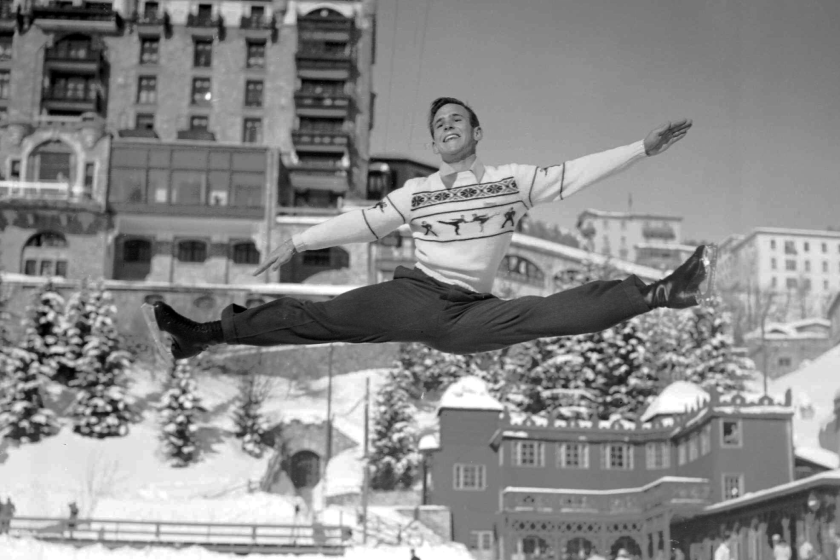Weather adds an air of dangerous unpredictability to skiing

- Share via
BEIJING — A small army of workers fought the snow with brooms, flat-edged shovels and leaf blowers in a cacophony of scraping and high-pitched whirring that drowned out the public-address announcer’s shouts for each skier fortunate enough to cross the finish line at the Yanqing National Alpine Centre.
The popular Winter Olympics mascot, Bing Dwen Dwen, waddled aimlessly through the empty grandstands as snow accumulated around the panda’s saucerlike eyes. Staffers built snowmen wearing KN-95 masks, others fashioned snowballs or stared at the final stretch of the steep Ice River course that seemed to vanish into an impenetrable bank of fog and snowflakes.
The men who staggered away from the finish after the first run of the giant slalom Sunday morning had never experienced anything like it.
“The first run was far from responsible in my opinion,” Austria’s Manuel Feller said.
“When it’s these conditions in training, we never ski,” Italy’s Luca De Aliprandini said.
After failing to finish in the giant slalom and slalom, American Mikaela Shiffrin gets back on the path toward normalcy with ninth-place in super-G.
“There were moments where I didn’t really know where I was or where I was going,” France’s Mathieu Faivre said.
Norway’s Henrik Kristoffersen summed up the problem in a language that crossed international boundaries: “I didn’t see s—.”
Racing down the side of a mountain at speeds that can approach 90 mph is challenging enough, but Alpine skiers must also contend with ever-changing weather. An ill-timed gust of wind, the sun breaking through clouds — or vanishing behind them — can transform a course from one minute to the next.
“The variables out of your control are insane,” said Karin Harjo, the U.S. women’s World Cup speed team coach. “The snow changes from top to bottom. The course changes all the time. It’s like if you’re playing basketball and said, ‘OK, the hoop is going to be eight feet, then it’s going to be 12 feet, and then in the fourth quarter it might be seven feet.’ You have to adapt so much.”
Added two-time Olympic gold medalist Ted Ligety: “It’s not like a lot of other sports where if you’re in a pool or on a track where the venue is basically the same every single time. In Alpine skiing, the venue changes person to person.”
Before the Alpine competition started, Mikaela Shiffrin summed up worries of many competitors about gusts in the Xiaohaituo Mountain Area upending a run. Some observers have compared portions of the downhill course named the Rock to a wind tunnel.
“You could do everything right and get a gust of wind, and that’s that,” she said. “You control what you can control and try not to get too disappointed. Every now and then, there’s a major tornado gust you get totally lost in.”
That wind, gusting up to 40 mph, forced the men’s downhill to be postponed by a day and delayed the start of the women’s downhill. That kind of issue isn’t unusual — high wind threw the Alpine schedule into chaos at the Pyeongchang Games four years ago. Uncertainty is a foundation of life as a ski racer.
Just over a year after a devastating crash he still can’t remember, U.S. skier Tommy Ford returned to competition Sunday at the 2022 Winter Olympics.
“It would be nice to jump in a pool and not have the fear of injury because you know what you’re going to endure the whole time,” downhiller Jackie Wiles said. “At the same time, I think that’s the beauty of our sport because there are so many factors to be able to compete well. You have to be able to adapt in an instant.”
The snow that started early Sunday was different. The region averages less than eight inches each year, so the runs were built with man-made snow that skiers described as aggressive and unforgiving. No one expected a near-blizzard to disrupt the Games.
But almost four inches had fallen by the start of the giant slalom Sunday morning and the storm intensified as each skier made his way down the mountain.
Lines of blue dye that mark the path through the course disappeared, despite course workers attempting to redraw them after each run. The blue-and-orange gates were barely visible. It was like skiing while blindfolded.
Wind whipped snow across the man-made surface. Spots were uneven, aggressive, slick, bouncy. There was little, if any, time to react.
“With no visibility, you’re not able to ski around the rough stuff, you’ve just got to go through it,” Norway’s Lucas Braathen said. “Sometimes there’s clean surface, others there’ll be rough.”
Thirty-three of the 87 men who started the first run didn’t finish. They included Americans Luke Winters and Ryan Cochran-Siegle.
“It’s man versus man but also man versus course,” said teammate River Radamus, who finished fourth. “It really does feel like doing battle out there.”
The second run that afternoon was delayed. Course workers finally gained ground on the snow as the storm eased. Visibility improved. Only seven skiers didn’t make it down the mountain. The course had changed again.
“It has been a very tough race for sure with challenging conditions,” said Switzerland’s Marco Odermatt, who won the gold medal with a dramatic second run, “but it was more or less the same for everybody.”
He had survived.
More to Read
Go beyond the scoreboard
Get the latest on L.A.'s teams in the daily Sports Report newsletter.
You may occasionally receive promotional content from the Los Angeles Times.









